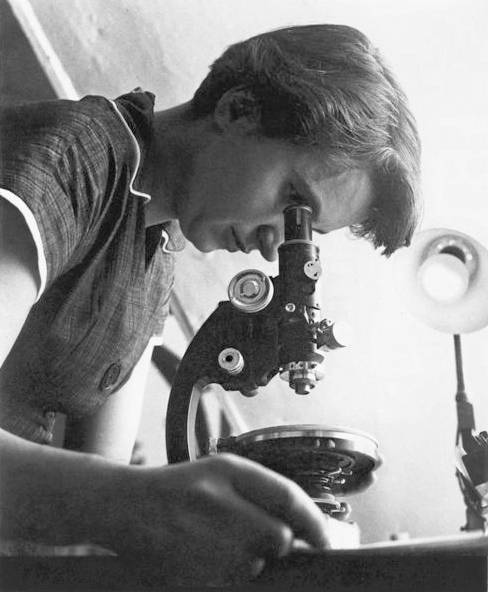
FAQ About Rosalind Franklin

Who was Rosalind Franklin?
Rosalind Franklin was an English chemist and X-ray crystallographer whose work was critical in understanding the molecular structures of DNA, RNA, viruses, coal, and graphite. She is best known for her role in the discovery of the DNA double helix structure.

What is Rosalind Franklin famous for?
Rosalind Franklin is most famous for her contributions to the discovery of the structure of DNA. Her X-ray diffraction images of DNA, particularly the famous Photo 51, were crucial to identifying the structure as a double helix.

What was Photo 51 and why is it important?
Photo 51 is an X-ray diffraction image of DNA taken by Rosalind Franklin and her doctoral student Raymond Gosling in 1952. It provided essential insights into the helical structure of DNA, which contributed significantly to the work by Watson and Crick on the double helix model.

How did Rosalind Franklin contribute to the discovery of DNA's structure?
Rosalind Franklin's precise X-ray diffraction work provided critical evidence of DNA's helical structure. Her photograph known as Photo 51 enabled Watson and Crick to analyze the dimensions and shape of the DNA double helix, which were crucial for constructing their model.

When and where did Rosalind Franklin conduct her research?
Rosalind Franklin conducted her research on DNA at King's College London from 1951 to 1953. She later conducted research on the molecular structures of viruses at Birkbeck College, London, from 1953 until her death in 1958.

Did Rosalind Franklin receive a Nobel Prize for her work?
No, Rosalind Franklin did not receive a Nobel Prize. The 1962 Nobel Prize in Physiology or Medicine was awarded to James Watson, Francis Crick, and Maurice Wilkins for the discovery of the DNA structure. Franklin had passed away in 1958, and Nobel Prizes are not awarded posthumously.

What were the challenges Rosalind Franklin faced during her career?
Rosalind Franklin faced several challenges, including gender biases in a predominantly male scientific community. Her work was often undervalued, and she did not initially receive due credit for her contributions to the discovery of the DNA structure. Additionally, she experienced tense relations with some of her colleagues.

How did Rosalind Franklin's work impact modern science?
Rosalind Franklin's work laid the foundation for modern genetics and molecular biology by helping to clarify the structure of DNA. Her pioneering techniques in X-ray crystallography have contributed to countless scientific advancements, including more accurate drug development and understanding of genetic diseases.

What educational background did Rosalind Franklin have?
Rosalind Franklin earned a degree in Natural Sciences from Newnham College, Cambridge in 1941. She then completed her PhD at Cambridge, focusing on the porosity of coal, before moving into X-ray crystallography.

How did Rosalind Franklin influence the field of X-ray crystallography?
Rosalind Franklin refined X-ray crystallography techniques to yield high-quality photographs, which allowed for more accurate interpretations of structures at the molecular level. Her meticulous methods set new standards in crystallography.

What other research did Rosalind Franklin contribute to aside from DNA?
Apart from DNA, Rosalind Franklin conducted significant research on the molecular structures of viruses, particularly tobacco mosaic virus and polio virus. She also worked on the physical chemistry of carbon and coal.

What is the significance of Rosalind Franklin's work on viruses?
Rosalind Franklin's research on viruses, particularly the tobacco mosaic virus, provided crucial information about the structure and replication of these viruses. Her studies contributed to the broader understanding of virus architecture and function.

Was Rosalind Franklin recognized during her lifetime for her contributions?
While Rosalind Franklin was respected for her meticulous scientific approach, her most famous contributions were not widely recognized during her lifetime. Much of her groundbreaking work on DNA gained the recognition it deserved posthumously.

How did Rosalind Franklin's work influence the discovery of RNA structures?
Franklin's techniques in X-ray diffraction and her insights into helical structures helped in understanding RNA configurations, paving the way for future researchers to elucidate the complexities of RNA molecules.

Did Rosalind Franklin have any collaborators on her DNA research?
At King's College London, Rosalind Franklin worked closely with Raymond Gosling, a PhD student, on X-ray diffraction studies of DNA. Her relationships with colleagues such as Maurice Wilkins were strained, which affected how her contributions were viewed and utilized by others, including Watson and Crick.

What legacy did Rosalind Franklin leave behind?
Rosalind Franklin's legacy is one of tenacity and brilliance in scientific research. Despite not receiving recognition during her lifetime, her contributions to DNA and virus research have left a lasting impact on the scientific community, inspiring future generations of researchers, especially women in science.

How has Rosalind Franklin been commemorated in modern times?
Rosalind Franklin has been commemorated in various ways, including through buildings and awards named in her honor, such as the Rosalind Franklin University of Medicine and Science. Her contributions have been recognized in numerous documentaries, books, and educational programs emphasizing women in science.

What personal attributes helped Rosalind Franklin succeed in her scientific endeavors?
Rosalind Franklin was known for her determination, meticulous attention to detail, and unwavering commitment to scientific accuracy and perfection, which were key to her success in research and discoveries.

Has Rosalind Franklin become a symbol for women in science?
Yes, Rosalind Franklin has become an emblematic figure for women in science due to her groundbreaking contributions and the challenges she overcame in a male-dominated field. Her story emphasizes the need for recognition and fairness in scientific achievements.

What was Rosalind Franklin's impact on the coal industry?
Rosalind Franklin's early work involved studying the porous nature of coal, which helped to understand how gases move through coal. Her research was influential in the carbon science field, impacting energy production technologies.
